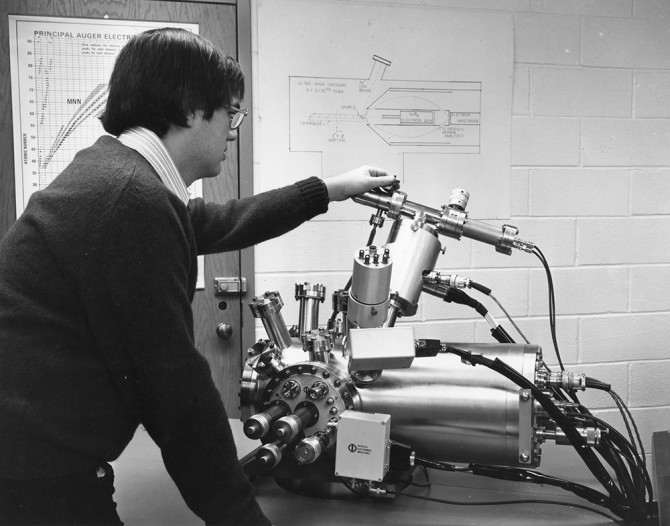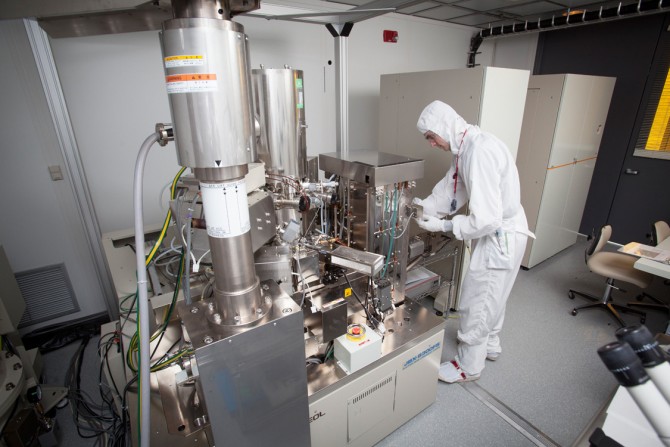NanoScale Facility to celebrate 40 years of nanotech, focus on future
By Syl Kacapyr
The Cornell NanoScale Science and Technology Facility (CNF) is celebrating its 40-year anniversary Thursday, Sept. 14, with a full day of presentations and panel discussions on campus that will both reflect on its contributions to nanotechnology and focus on its future.
When it opened in 1977 as the National Research and Resource Facility for Submicron Structures, it was the only facility of its kind, welcoming scientists and engineers across the country to conduct research on a scale approximately 75 times smaller than the width of a human hair. It operated out of Phillips Hall and contained about $4 million in research equipment.
Today, CNF is part of a larger national network of facilities and conducts research on the nanometer scale – about 50,000 times smaller than the width of a human hair. With about $75 million in equipment, the Duffield Hall facility operates 24/7, serving about 600 users a year who conduct research in the fields of biology, electronics, materials science, optics and physics.
One aspect of the facility that hasn’t changed in 40 years is its expert staff and service-oriented culture, according to Christopher Ober, CNF director.
“A lot of other places bring you in and say, ‘These are the instructions, don’t break the equipment,’” Ober said. “Our staff invests the time in teaching people how to design processes.”
Lynn Rathbun has helped to build that culture of service from the beginning. Now CNF’s laboratory manager, Rathbun is the lone active staff member from the days when the facility was billed as a place for submicron experimentation.
“Originally, CNF was envisaged as primarily a research facility, with equipment and process support provided by graduate students,” said Rathbun. “It soon became apparent that professional? staff were a necessity. Now, the experienced staff of CNF are, in fact, its most valuable and distinguishing characteristic.”
Said Donald Tennant, CNF director of operations: “This is a completely agnostic kind of organization that specializes in bringing in people who have never been here before and getting them up to speed rapidly.” He said CNF has remained a top destination for nanotechnology research because of how it has applied its capabilities to multiple areas of research, not just electronics.
CNF has increased its intellectual footprint and facilitated breakthroughs in micro- and molecular electronics. It has also helped lead the fields of magnetic storage and nanobiotechnology, and studies in energy-related systems like batteries and carbon nanotubes.
To understand the facility’s impact on science, Tennant said one need look no further than its research output. About 100 patents and patent applications are rooted in CNF research each year, as well as about 500 publications, many in top-tier academic journals. Tennant estimates roughly $40 million to $60 million in annual research funding is obtained by facility users.
“Also, look at research that has been translated into real companies,” said Ober. “Just in recent times: microelectromechanical company Kionix, laser-technology company Binoptics – which was sold to MACOM – and Pacific Biosciences, which is a half-billion-dollar biotech company.”
But CNF’s 40th anniversary isn’t just about looking back. People from academia, industry and government will be asked to participate in workshops to help predict the future of nanotechnology research.
“That will help us think about where CNF should go, what unique strengths we can bring to nanoscience, and what kind of facilities and capabilities need to be created to realize this,” said Tennant, adding the information will be compiled into a document that will help guide future CNF decisions.
“You would think after 40 years we’d have it all down pat,” Ober said, “but in fact there’s just tremendous opportunities to try new things, and there’s constantly new challenges.”
One of those challenges is purchasing new equipment. CNF was founded and receives most of its funding from the National Science Foundation, but its funding model is changing as competing facilities emerge. Ober says CNF increasingly relies on the generosity of alumni donors with a passion for advancing nanotechnology and keeping Cornell at the forefront of the field.
That funding also benefits students, according to Ober. About 320 Cornell graduate students use the facility annually, and dozens of them will showcase their research during a poster session at the anniversary event.
The celebration is open to the public but a registration fee is required. Register at the start of the celebration event in Room G10 of the Biotechnology Building.
Syl Kacapyr is public relations and content manager for the College of Engineering.
Media Contact
Get Cornell news delivered right to your inbox.
Subscribe
